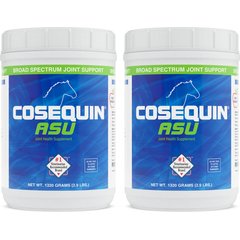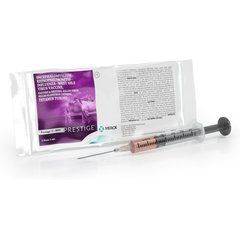Clostridial Myositis in Horses
What is Clostridial Myositis in Horses?
Clostridial myositis is a relatively uncommon condition in horses but can be life-threatening. It is considered a serious bacterial infection causing inflammation and death of muscle, which releases bacterial toxins in the bloodstream.
The most common cause of clostridial myositis in horses is secondary to an intramuscular injection, or a deep wound. Clostridial myositis is also referred to as malignant edema, gas gangrene, and myonecrosis.
Shop Horse Products
- Tribute Equine Nutrition Kalm N' EZ Pellet Low-NSC, Molasses-Free Horse Feed, 50-lb bag$25.49Chewy Price
- Nutramax Cosequin ASU Powder Joint Health Supplement for Horses, 2.86-lb tub, bundle of 2$279.98Chewy Price
- Absorbine ShowSheen Instant Detangling Hair Polish & Detangler Horse Spray, 32-fl oz bottle$17.84Chewy Price
- Prestige 5 + WNV Vaccine for Horses, 1-mL syringe$53.99Chewy Price
Symptoms of Clostridial Myositis in Horses
Clinical signs of clostridial myositis typically occur within 6-72 hours of an intramuscular injection or deep wound.
Initially, symptoms at the affected area may include:
-
Swelling
-
Heat
-
Pain
-
Fluid or discharge
Bacterial clostridia typically produces gas that results in a bubbly or crepitus (crackly) feel under the skin in the affected area.
If left untreated, disease progresses rapidly and the horse's condition can decline within hours, causing the horse to go into a state of Systemic (whole body) Inflammatory Response (SIRS). Symptoms of SIRS include:
-
Fever
-
Lethargy
-
Depression
-
Increased heart rate
-
Increased respiratory rate
-
Progressive toxemic shock
-
Death
Clostridial myositis is a medical emergency–if you see any of these signs in your horse call your primary or emergency veterinarian immediately. Fast, aggressive treatment is imperative to save your horse.
Causes of Clostridial Myositis in Horses
The most common reason for clostridial myositis in horses is secondary to an intramuscular infection. Some of the medications that can cause this include:
-
Banamine (flunixin meglumine)—most common
-
Ivermectin
-
Progesterone
-
Antihistamines
-
Phenylbutazone (bute)
-
Dipyrone
-
Vitamin B complex
-
Synthetic prostaglandins
Clostridial myositis can also occur with a deep penetrating wound or deep wound contamination.
Clostridium is an anaerobic bacterium meaning it thrives in environments where there is little or no oxygen. With either an intramuscular injection or a deep wound, there is muscle damage that occurs at the site which allows for an environment without oxygen. This then triggers increase of the clostridum bacteria and release of toxins. The release of toxins causes extensive tissue and vascular damage.
There are over 150 known species of clostridium, but only three that most commonly cause myositis:
-
C. perfringens
-
C. septicum
-
C. chauvoei
Horses can be infected with one of these species or a mixed infection. C. perfringens typically has a lower fatality rate compared to C. septicum and C. chauvoei.
How Veterinarians Diagnose Clostridial Myositis in Horses
Your veterinarian can typically diagnose clostridium myositis by history and physical exam. Your veterinarian may take a sample of fluid from the affected area and send it off to the lab to identify the specific bacteria.
Treatment of Clostridial Myositis in Horses
Treatment for clostridial myositis often includes a variety of aggressive approaches. Large incisions are made into the skin and muscle of the affected area to expose the bacteria to oxygen and debride (remove) any dead tissue.
Supportive care is often required as many horses have secondary effects from the spread of the toxins. Horses are commonly treated with high doses of antibiotics such as penicillin and metronidazole, intravenous fluids, anti-inflammatory medications (banamine or bute), cardiovascular support, and wound care.
Recovery and Management of Clostridial Myositis in Horses
The survival and recovery rate of clostridial myositis is reported to be between 31-73%. Horses that survive the initial toxemia stages of the disease appear to have an improved prognosis.
In order to treat the affected area, the incisions and wounds are often large and deep. Wounds can take weeks to months for the skin and muscles to completely heal depending on the severity and fast, aggressive treatment.
It is common for extensive skin sloughing (skin dying and falling off) to occur with horses that survive. Once a horse has recovered, unless it has permanent systemic damage to an organ system, it can likely go back to normal exercise and lifestyle. There may be significant scarring or muscle damage to the affected area which could lead to decreased strength long-term depending on the location and severity.
Horses that do not survive often die due to systemic inflammation and multi-organ failure.
Clostridial myositis can lead to other conditions such as:
-
Cardiovascular damage
-
Kidney damage
-
Immune Mediated Hemolytic Anemia (IHMA)
-
Respiratory difficulties
-
Swelling/edema
Prevention of Clostridial Myositis in Horses
When giving intramuscular injections, always use large, well vascularized muscle groups. Monitor for signs of swelling, gas pockets, fever, or depression and call your primary veterinarian right away if you suspect any of these.
Location of injection sites should be in areas that can easily drain such as neck, pectorals (chest), and low on the hind end (gluteal muscle).
When possible, avoid giving any injections in the muscle. Many substances can be given by alternative route such as oral or intravenous administration.
References
1. Stewart, A. DVM 360. Clostridial myositis (Proceedings). 2011.
2. Teixera R, Valberg S, Phd D. THE RISK of ADMINISTRATION of INTRAMUSCULAR DRUGS such as BANAMINE® to HORSES.
3. Valberg, Stephanie. Merck Veterinary Manual. Infectious Myopathies in Horses. 2019.
Featured Image: iStock.com/superoke




